| 
Go to the www.icermax.com website for more information.
 Overview of iCerMax product range Overview of iCerMax product range
Bulk Tank Filtration
Bulk filtration at main fuel and oil tanks
Bulk filtration is overlooked in the market place, and either doesn’t exist or is inferior. Non sustainable filters are installed, that simply don’t have the dirt holding capacity, nor handle the multiple surges or are inadequately maintained. This practice places vast pressure on the OEM filters of equipment and is directly responsible for warranty claims, the shorter economical lifecycles of equipment, higher maintenance costs and poor fuel consumption figures. Both water and particle contamination needs to be addressed on a sustainable and economically viable basis, with ease and clear maintenance intervals. There are multiple sites where the pressure gauges indicate positively that there is no flow restriction and that filtration is in progress. But yet the filtration medium is totally compromised. iCerMax medium’s integrity can’t be compromised. The gauges will indicate the true reflection of dirt contained without any iSo-SpecSure™ filtration medium compromise.
iCerMax™ ensures that if liquids flow through the depth iSo-SpecSure™ medium, the cleanliness levels are sustainably improved and unconditionally obtained. The iCerMax™ medium can’t fail and the pressure gauges provide an accurate reflection of the filter’s lifecycle.
All-in-one iCerMax™ “Plug and Go" Combo Skid System
This unit offers the complete solution for addressing bulk tank contamination (both particle and water). It does so cost effectively with long maintenance intervals, low running costs with easy installation.
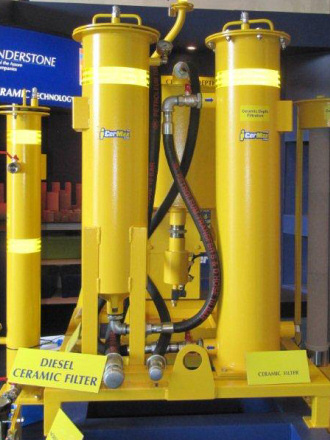 |
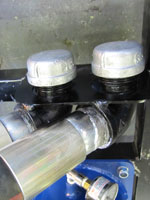
Connect External Hoses |
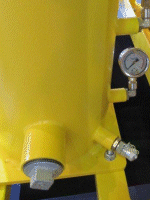
Mini Mesh Sample Units |
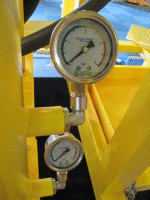
Gauges to Monitor |
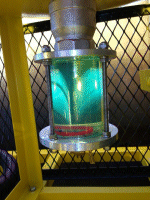
Fuel Visual Inspection |
The iCerMax™ iSo-SpecSure™ steel filter and coalesce water separator is fully assembled on a steel frame with all connections, internal hoses, gauges and sample units installed. Only connect the current dispense hose to the dispense connection and connect the hose provided to the inlet connection. Secure the unit to the floor and it is fully installed. Addresses water and particle contamination at main source, lowering the overall contamination count, lowering downstream filter compromise on capacity and sustainability improving overall cleanliness levels.
Fuel skids (custom made)
There are various combinations to accommodate your specific requirements, with our iSo-SpecSure™™ filtration medium; we can offer direct unique benefits.
It is advisable to fit an iCerMax™ bulk combo unit to the bulk fuel tanks and the iCerMax DUO on to mobile equipment - The end result is lower operational costs all-round, and a multi stage filtration approach, which leads to effective and sustainable filtration.
It is expensive to create bottle neck filtration and then to rely on filters with black hole characteristics which allow unlimited superfluous use, due to compromise of their fiber/synthetic mediums, without obtaining the required cleanliness levels.
Unequivalent water separator- for Africa's water levels, which commonly exceeds 5%

 Read more iAquaMax | For more information please visit the www.icermax.com website Read more iAquaMax | For more information please visit the www.icermax.com website
Automated coalesce water separator, 300 liters per minute – no cartridge required, automated water dumping
The “silent killer” – Water has inferior lubrication properties, pressure, corrosion, fuel oxidation, viscosity, bacterial & fungi .etc.
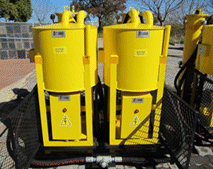 Utilise the coalesce principle - a reliable, proven and effective method. Highly effective water separation without the cost of expensive cartridges that collapse with a high volume of water concentrate and whose efficiency is compromised by particle contamination. Automatically dumps water in 500ml intervals. Utilise the coalesce principle - a reliable, proven and effective method. Highly effective water separation without the cost of expensive cartridges that collapse with a high volume of water concentrate and whose efficiency is compromised by particle contamination. Automatically dumps water in 500ml intervals.
- Highly effective separation up to 300 liters per minute
- Ideal” policeman " to combat the practice of diluting fuel with water during delivery to main tanks and to indicate dilution on equipment - an African practice of note.
- Ideal for Africa as the separator can consistently handle up to 5% of water per volume. Most cartridge filters simply collapse or saturate at these water volumes. Flow volume limited to 150 litres per minute
- No costly cartridge that has water absorption limitations
- Automatically “dumps” water with iCerMax™ technology into a separate container and no operator intervention is required
- Long life due to robust construction
- Possesses no water absorption media which is sensitive to flow rate and surges
- Particle contamination negatively effects the water retention ability of cartridges (wax & coalesce fibre media)
- Flow rate - 300 litres per minute
- Volume size – 600 X 600 X 1100
- Weight – approx 65kg
Allows effective upstream removal of water contamination before entering the equipment or vehicle’s fuel tank.
Highly effective at any sample interval, during and throughout operation
Not a water or wax based absorption or coalesce cartridge media whose efficiency deteriorates as it reaches saturation or is diversely affected by dirt contamination and then has a direct drop in efficiency
|
|
Officially this site has no water problem? But water is dumped automatically at regular intervals. As the free water is removed from the diesel during dispensing. |
Applications
- Main fuel tanks water separation /filtration - 300 liter. With free water levels higher than 5% volume, flow rate limited to 150 litres per minute - fit two units in parallel.
- Inbound filtration into bulk tanks, cleans fuel during tanker delivery up to 1050 lpm ( see inbound filtration )
- Ideal for kidney systems as utilised in– iCerMax’s fuel kidney recirculating filtration systems for fuel bowsers and genset ‘s
- There is a full range - iCerMax DUO of smaller units for onboard vehicles /equipment available that caters for all flow rates and mobile fuel tanks.
Inbound filtration
Filtration of fuel (particle and water) during the offloading process, from a tanker into bulk storage tanks, up to 1050 l/p/m . This was developed as a result of a request from our clients in Africa. The unit allows a three stage filtration. Providing unsurpassed cleanliness levels in bulk tanks and monitoring the dirt and water levels during each fuel delivery in real time.

The system is modular based and easy to install without high installation costs.
It offers low maintenance as the only consumable is the filter bags.
Flow rates from 300 l/p/m to 1050 l/p/m are easily accommodated.
 Read more iCerMax™ - Inbound Filtration Combo Unit into bulk tanks (STD) Read more iCerMax™ - Inbound Filtration Combo Unit into bulk tanks (STD)
Amber diesel -Orange juice – silent failure- “Water added to diesel during deliveries ‘’
 |
- Not detected by water finding paste
- Not removed by absorption medium nor “normal market “filters
- However our Water separator efficiency does show its presence
- This amber diesel that would directly go to the combustion chamber with damaging consequences
- A large percentage of failure is not particle contamination but actually water related failures
- Usually detected during OEM warranty claims investigations
|
Free water in diesel dispensed fully automatically
System remains optimal with no efficiency loss- due to no capacity problems as it operates on a coalesce pressure system and therefore does not suffer from the same capacity constraints associated with normal filters, Normal filters have capacity constraints and get blocked by sheer water volumes or particles effecting their water separation abilities.
|
Spin-on filters at bulk fuel and oil tanks

iCerMax™ iSo-SpecSure™ spin on filters can fit directly to your current filter housing, as they come in a full range of various head sizes. Ideal to filter fuels, oils, gasses and air.
iCerMax™ can handle the multiple surges, pressures, high flow rates and vast dirt capacity with ease on a sustainable basis. ”if it flows through iCerMax™, the cleanliness levels are sustainably improved, with depth filtration cleanliness levels”. iSo-SpecSure™ medium simply can’t compromise; it provides surety on sustainable filtration.
Normal filtration medium, even expensive synthetic filters, will compromise which leads to intermediate filtration. The lack of sustainable filtration on bulk tanks places enormous pressure on OEM equipment filters, as both the pre-filters and filter have dirt holding capacity constraints. Struggling to “cope” on the mere capacity of contamination levels it has to accommodate, will compromise the filtration medium. If the OEM equipment filters utilise wax, silica or cartridge based filters for water separation, it is directly compromised by particle contamination to perform this function. This leads to direct water contamination.
TOO MANY PARTICLES CAUSE THE FILTERS TO PLUG.
This results in large numbers of particles being forced through.
This gets progressively worse as the differential pressure across the filter increases.
Vibration & surges accentuate the problem.
iCerMax™ Filtration Media simply can’t compromise
|
All-in-one-mini iCerMax™ “Plug and Go" Combo system
This unit accommodates smaller flow rates as the coalesce water separators capacity is limited to 75 litre per minute and utilises iSo-SpecSure™ spin-on filters for particle filtration.
Ideal for mobile tank applications
 iCerMax™ iSo-SpecSure™ & desiccant air vent breathers for bulk tanks iCerMax™ iSo-SpecSure™ & desiccant air vent breathers for bulk tanks
The atmospheric breather is an air, dirt and water filter/breather for use on the tank vent of diesel fuel storage tanks both above and below ground. The particle filter media is the iCerMax™ Depth micron filter, which removes moisture from the air going in and out of your tank. By replacing your current tank vent (which keeps out only bricks and stones) on your diesel fuel storage tank with the iCerMax™ breather, you virtually eliminate a primary source of dirt and water contamination in your fuel.
iCerMax™ utilises a unique three valve system to ensure longevity of the desiccant, even at high humidity levels – coastal regions or during rainy seasons.
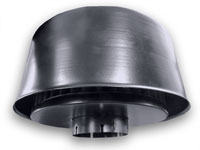 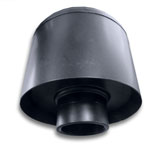
Why upstream filtration?
The more contamination is excluded from entering the fuel and filtered upstream the more reliable and effective the downstream filters can “cope” with particle and water contamination levels.
|
back to top
Equipment Filtration
On equipment filtration range
This filtration range does not replace OEM filters, as it will compromise your warranty.
These are additional pre-filters to ensure your OEM filters are not compromised on capacity and ensure the efficiency of OEM standard fitted filters. They allow OEM filters to function in ideal conditions.
The iCerMax™ iSo-SpecSure™ filters extend your economical lifecycle of engines and equipment due to the inherent characteristics that iSo-SpecSure™ filtration offers. The iCerMax™ Filtration System is a “Bulldog" when it comes to Africa’s contamination levels.
It is widely accepted that the additional cost of implementing these filters, will be recovered via: the longer economical lifecycle of equipment, less equipment failure and your fuel bill reduction alone will pay the associated costs, due to less internal engine wear and extended combustion efficiency
 Duo-Aqua Trap Brochure | For more detailed information please visit the www.icermax.com website Duo-Aqua Trap Brochure | For more detailed information please visit the www.icermax.com website
The coalesce principle is utilised - a reliable, proven and effective method. Highly effective water separation is achieved without the cost of expensive cartridges that collapse with a high volumes of water concentrate and whose efficiency is compromised by particle contamination, OR where the water absorption simply exceeds the water holding capacity.
Sustainable filtration directly extends the economical lifecycles of engines, lowers maintenance costs and directly leads to lower fuel consumption as the efficiency in internal combustion is maintained, due to less internal wear on components, for example on the fuel injectors.
It is advised to fit an iCerMax™ bulk combo unit to the bulk fuel tanks and the iCerMax DUO on the equipment – The end result is lower operational costs all-round, and a multi stage filtration approach, which leads to effective, sustainable filtration.
It is expensive to create bottle neck filtration and then to rely on filters with black hole characteristics.
“Under normal highway conditions the air consumed in a 16 litre engine contains almost 20 kilograms of dirt/contaminants per 100 000 kms.” - Fleetguard
Mobile tanks
There are various case studies of equipment failure directly contributed to contamination from mobile tanks.
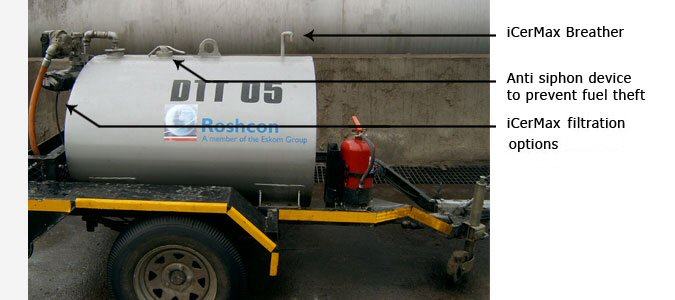

To enable adequate filtration one requires pressure pumps and sustainable micron filters. To fit hand pumps with ”mesh” filters is simply inadequate to obtain any cleanliness levels.
The mobile trailer is custom designed to enhance the fluid's cleanliness levels. Due to the characteristics of iSo-SpecSure™ filtration a sustainable cleanliness level is ensured at all times.
The trailer is functional and does not require constant maintenance as it has no cartridges or small strainers that block constantly needing to be changed. Nor does it allow unlimited superfluous use like other filters do, due to the compromise of their fiber/synthetic mediums, without obtaining the required cleanliness levels.
Fuel theft is dealt with a superior anti-siphon device that is fitted above the tank.
It is advised to fit an iCerMax™ bulk combo unit to the bulk fuel tanks and the iCerMax™ DUO on the equipment - The end result is lower operational costs all-round, and a multi stage filtration approach, which leads to effective, sustainable filtration.
It is expensive to create bottle neck filtration and then to rely on filters with black hole characteristics.
Contamination blue print
It is imperative to address the entire contamination blue print for optimal results.
From bulk tanks, mobile tanks and physically on the equipment. If one ignores any of the major steps, it places critical pressure on the other areas. This is why there is excessive wear and failure of equipment, as the OEM filters simply can’t cope with the pure capacity of contamination, irrespective of their micron rating or filtration medium. BUT the smaller the micron rating the worse the capacity constraint, being a paper or synthetic filtration medium, as the shear particle volume increases exponentially.This is where iCerMax™ is setting new standards in sustainable micron filtration.
The rule is simply: prevent contamination (water & particle) from entering and lower contamination levels throughout the handling process.
back to top
Kidney Filtration
Please visit the www.icermax.com website for more information
iCerMax™ - Kidney Systems
iCerMax™ - Gensets / Fixed storage tanks
Fully automated cleaning system to ensure the diesel remains in an optimal condition.
The answer to preventing the catastrophic non start-up of crucial equipment.
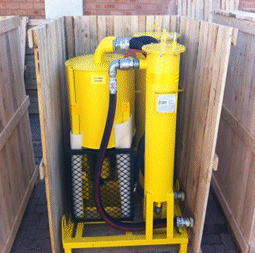 |
- Circulates diesel to avoid diesel separation
- Removes water and particle contamination
- Automatically dumps free water, as water
retained in the system causes algae and fungal
growth to start by providing the habitat and
food for such growth
- Thus prevents algae and fungal growth
- Totally programmable operational intervals,
similar to a swimming pool
- Two pressure gauges to accurately monitor
the condition of the iCerMax™ iSo-SpecSure™ filter
life
- Warning systems to ensure functionality
- Easy to install with low maintenance
- Ensures diesel remains optimal
- Customised to each site's requirements
|
Fuel & Oil Kidney Systems
Flow rates from 40 – 300 ltr per minute in oils and fuels
iCerMax™ - Two stage Portable Filter Trolley
The trailer is functional and does not require constant maintenance as it has no cartridges or small strainers that block constantly needing to be changed. Nor does it allow unlimited superfluous use like other filters, due to the compromise of their fiber/synthetic mediums, without obtaining the required cleanliness levels.
- Suitable for both diesel fuels and hydraulic oils
- Transfers and cleans fluids in the same operation
- High flow rate - constant flow 72 ltr/pm until 4 bar
- iCerMax™ iSo-SpecSure™ medium ensures sustainable cleanliness levels and accurate monitoring
- Cleans and transfers a 210 ltr oil drum in under 3 minutes
 Read more iCerMax™ - Two stage Portable Filter Trolley Read more iCerMax™ - Two stage Portable Filter Trolley
 Read more iCerMax™ - Two Stage Portable Filter Gear Pump Read more iCerMax™ - Two Stage Portable Filter Gear Pump
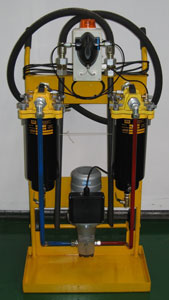
Fuel/Oil Portable Kidney filtration trolley @ 40 litres per minute
Used in oil transfer and cleaning of tanks. Advisable to utilise even
with”new” oils, as the oil is below required cleanliness levels, especially in hydraulics.
- Used for both diesel and hydraulic oils
- Transfers fluids and cleans the fluids in the same operation; 40 litre p/minute
- iCerMax™ supplies prefilter cartridges with vast life cycles and ensured sustainable cleanliness levels for optimal performance of the delivery filter to remove water.
- Removes water effectively by coalesce, adsorption or separation medium, full flexible range of cartridges for delivery filter
- Only removes harmful contaminates and will not disarm the additive pack on new oils
- Cleans until it is in “spec” with iCount indicator
- Strong powerful motor & industrial construction
- Cost effective – lasts multiple lives of the spin-on
- Customised with pressure gauges and mini mesh sample units
- Large range of cartridges with various microns ratings
This system is of industrial quality with high efficiency and is cost effective. It is mobile and most importantly user friendly.
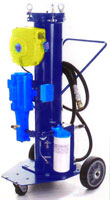 Fuel/Oil Portable Kidney: filtration trolley (customised litre per minute) Fuel/Oil Portable Kidney: filtration trolley (customised litre per minute)
Transfers fluids and cleans them in the same operation, for example from delivery drum to equipment.
Custom built for various applications or as per client’s own specifications
- Ideal for “breaker oils “ , highly contaminant liquids or large volumes at high flow rates.
- iCerMax™ supplies pre-filter with vast dirt holding capacity and ensuring sustainable cleanliness levels during the entire filtration process. With 2,7m iCerMax™ iSo-SpecSure™ core. Fitted with pressure gauges and mini mesh sample units.
- Removes water by coalesce, absorption or separation medium, full flexible range of cartridges for own custom delivery filter. FBO, spin-on, etc.
- Removes harmful contaminates only, will not disarm additive pack on new oils.
- Robust, solid industrial construction.
- Sustainable cleanliness levels on particle contamination assured.
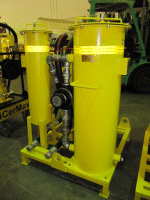 Combo unit Combo unit
Bulk tank kidney filtration for fuels at 75 - 300 l/p/m
- Water and particle contamination
- Kidney filtration for bulk tanks
- Timer function on pump
- Long maintenance intervals
- Sustainable iCerMax™ filtration
- Ideal for gensec’s and large bulk tank applications
See Combo unit in bulk filtration section for more detailed information
Customisation and shipping
We custom build our bulk units, filtration trollies, mobile trailers to clients' specific needs , requirements or specifications and ship all over the world - land, sea and air.

back to top
Particle and water contamination in fuels and oils
iCerMax™ iSo-SpecSure™ filtration is depth filtration with sustainable cleanliness levels.
iCerMax possesses characteristics that ensure a market advantage over other medium. Nowhere is this more apparent than when one applies iSo-SpecSure™s as a filter medium. This is not a new concept, as it is used extensively in water (capacity) and air (efficiency) filtration. iCerMax™ however saw the potential to use iSo-SpecSure™s for the filtration of hydrocarbons (fuels – diesel & petrol, oils-lubrication and hydraulics) - a new concept application in the global market.
With efficiency and cost, over the entire volume filtered at sustainable cleanliness levels, with no media collapse, no surge sensitivity, no channel formation or water sensitivity we are setting a new bench mark in FILTRATION with this non flexible, vast dirt holding capacity medium.
Especially when taking into consideration the versatility of the iSo-SpecSure™ medium.
iCerMax™ filter medium cannot be compromised; therefore “bad particle contamination” will lead to only filter blockage, not injector wear / failure or even engine failure. Normal filter medium will be compromised through various factors, most common on excess capacity and this will lead to contamination surges. There is a whole range of custom iSo-SpecSure™s designed for various applications and cleanliness levels.
A iSo-SpecSure™ fuel & oils depth filtration medium does not have any of the following depth filtration constraints:
- No water sensitivity at all (most depth filtration medium block with water instead of particle contamination)
- No channel formation or medium collapse
- Structural integrity - handles surges, pressure and heat with ease
- Ultra low resistance to flow and differential pressure
- Vast dirt holding capacity and high efficiency
- Physically separating clogging of hydrocarbons
And iCerMax™ offers:
- Absolute surety of sustainable filtration – 100 % medium integrity
- Dirt remains in filter – non flexible / non channel formation medium - in other words no dirt surges or any seepage
- Higher pressures obtainable and filter integrity not compromised on pressures exceeding 1.3 bar - iSo-SpecSure™s can handle high pressure, multiple surges, hammering effects, vibrations and high flow rates
- With higher pressures and its vast dirt holding capacity, bulk filtration is totally in a league of its own – setting new standards. With its high capacity it holds much more than current mediums do – thus it is ideal for refineries or bulk fuel tank installations
- Lower maintenance, less call outs, fewer resources required
- Wet start – no medium crunch or ripping due to initial flow surges
- Ideal for kerbside pump applications due to its low pressure and high surges nature
- Economical as it lowers cost per liter filtration with total confidence of sustainability
Depth filtration is closer to the perfect filter as it
conforms closer to filter performance criteria. The effective
repeatedly micron beta rating is substantially higher than surface
filtration and the ultra important beta stability remains (see ref) uncompromised
with our filter media. Therefore capable of continually removing
micron contaminantS at higher efficiency with vast increase in contaminant
holding capacity
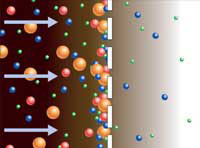 |
 |
| Surface Filtration |
Depth Filtration |
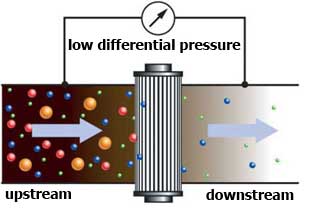 Both hard and soft contaminants penetrate into the depth
media. It captures contaminants within its structure, as opposed to
on the surface. Both hard and soft contaminants penetrate into the depth
media. It captures contaminants within its structure, as opposed to
on the surface.
Depth filtration – the General preferred technology –
uses a relatively large volume of porous filtering media to capture
contaminants at various depths deep within the filter element as
the fuel and oil passes through. Depth filters featuring this type
of construction provide maximum contaminant loading and long service
life with a greater filter efficiency over a variety of particle
sizes.
Semi-solid contaminants will penetrate the media and not glaze-over
the surface as per surface filtration.
”if it flows through iCerMax™, the cleanliness levels are improved and sustainable, with depth filtration cleanliness levels”. The iSo-SpecSure™ medium simply can’t be compromise and thus it provides surety on sustainable filtration
- Depth Filtration not surface filtration
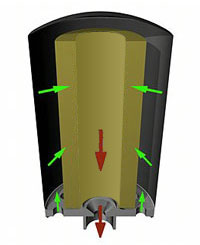
- Sustainable cleanliness levels with a single pass-100%
- High flow rates even with surges
- No channel formation or medium collapse
- Structural integrity – handles surges and contamination caking with ease
- High or low pressures, no element collapse
- Ultra low resistance to flow and differential pressure
- High efficiency - 100% sustainable
- Non flexi medium – improves filtration efficiency
- Vast dirt holding capacity -Long filter life: No water sensitivity
- Manufactured to ISO 12000, ISO 12001 and ISO 14000 standards
- Excels in all of the eight main filtration criteria
Benchmarking sustainable cleanliness levels in filtration of:
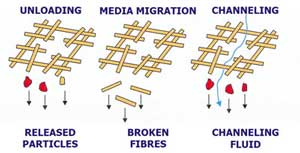
- Fuel (diesel, petrol & biodiesel)
- OIL (hydraulic, gearbox & engine)
- Coolant, Air, (liquid or gas)
- Industrial filtration
It is structurally sound and can’t do the following:
Filter Performance Monitoring –Cellulose & synthetic medium will “break” due to excess contamination and dirt -holding capacity limitations, surges, pressure variances, water, bio diesels, surfactants, alcohol, heat, biocides, etc. – iCerMax™ iSo-SpecSure™s simply can’t and don’t break as they are not subject to these limitations. iCerMax™ ensures sustainable filtration even on a single pass.
How clean is my fuel – test samples from two year old 83 m2 tanks – replenished every 48 hours
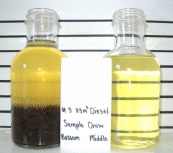 |
This is a sample from new tanks with a high turnover volume – with the assumption that the diesel must be clean.
Bottom sample - sedimint at bottom – large amount of metal particles, - Free water clearly visible with traces of fungal presence.
Middle sample – Clean and clear to the eye BUT it is over four times the SABS cleanliness spec, at over 80 mg /kg.
The particles you can’t see cause the most damage to your equipment and the smaller the particles sizes, the more the shear volume of dirt particles exponentially. |
Result of contamination

Levels of contamination
|
Sample of a patch magnified to 100X
showing a fluid at a cleanliness of approximately ISO 22/20/18, fairly typical of fuel at the filling pump |
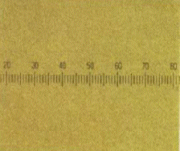 |
Sample of a patch magnified 100X showing a fluid cleanliness of approximately ISO 14/13/11, the target level for clean diesel fuel. |
Current cleanliness recommendations by some manufacturers of high pressure fuel injection systems have already indicated they need significantly cleaner fuels. They already require fuel in an ISO 4406 cleanliness range of 12/9/6 or better for on-vehicle filtration.
Several studies have been conducted on fuel cleanliness coming out of the pump, and it’s not uncommon to find a newly-delivered batch of diesel fuel with an ISO cleanliness level of 22/21/18. So who is signing up to cleaning diesel fuels to cleanliness levels of 12/9/6 or better?
Cleaning fuel from an ISO 4406 cleanliness level of 22/21/18 to approximately 12/9/6 or better requires approximately a one thousand times reduction in the particulate contamination.
 For more information please read: Fuel filtration reality check – paper no. IFC09-018 9Th international filtration conference, paper by Donaldson Filtration For more information please read: Fuel filtration reality check – paper no. IFC09-018 9Th international filtration conference, paper by Donaldson Filtration
 Contamination levels ISO 4406 explained Contamination levels ISO 4406 explained
back to top
Filtration Media Integrity

TOO MANY LARGE PARTICLES CAUSE THE FILTERS TO PLUG.
This results in large numbers of particles being forced through.
This gets progressively worse as the differential pressure across the filter increases.
Vibration, medium flexing & surges accentuate the problem. –
iCerMax™ doesn’t have this problem as the iSo-SpecSure™ medium simply can’t be compromised, even at the filter’s saturation point.
How long do you have effective 1 Micro filter Filtration taking into account all the multiple factors that impact on cellulose & synthetic filtration medium?
What is your filter’s official dirt holding capacity in ideal conditions?
How sure are you that your equipment’s filters are not compromised during time based service intervals? Simply install iCerMax™ filters next into your equipment and extend the economical lifecycle of your equipment.
iCerMax™ sets new market standards for:
Bulk tank filtration
Kerbside pumps
Filtration of 3rd party fuel - ensuring cleanliness levels on equipment
Sustainable filtration surety at bulk tanks, mobile bousers and on equipment.
Filtration impact
The cost of bulk filtration or additional pre-filter filtration, is a fraction of the down stream negative impact on equipment, if there is inadequate, non sustainable or even no bulk filtration. All filters today have excellent efficiency, but have capacity constraints / limitations that are exacerbated by surges and vibration. These capacity constraints in high quality filters are typically from 80g in trucks (440 hp) spin-on to 2kg in high quality bulk tank filters. This is concerning if it is taken into
consideration that every 50 liters of diesel is allowed 1g of dirt, on a 24mg / kg official fuel specification at oil companies point of sale.
Filters are more compromised on capacity than we realize in normal day to day service intervals.
This is frequently discussed in the press (read articles on our website)
The actual cost is neither unknown nor quantifiable, but filtration companies estimate that for every R1spent on filtration, R10 is saved. The lack of adequate or sustainable filtration has a direct proven impact on:
- Economical life cycle of equipment (minimum 20%)
- Maintenance cycles
- Engine failure - 70 % of engine failure is due to the Fuel system or heat
- Breakdown direct and indirect costs - Utilisation of equipment
- Fuel usage/ efficiency, especially later on in lifecycles 5-15%
- Soot / carbon build up, fuel dilution in oils
- Emission carbon footprint
The above impact on operational and capital costs are material, but we don’t comprehend the full impact as it is budgeted on the way we are used to operating. The current development into more advanced technology is going to be more of a culture shock, than the first advancement from ADE engines.
Some of the large mining groups are starting to materially invest in filtration, as they have realised the direct impact on their operational costs through case studies. Our medium does not compromise, even at filter saturation point.
Our Competitive Advantage is that our Brand of Products are unique and utilise patented concepts that provide both cost and functional benefits. They also compliment one another to provide a total solution to contamination, both particle and water in fuels & oils, materially lowering operational costs and extending the economical lifecycle of equipment.
back to top
Benefits of Filtration
Lack of sustainable filtration and its direct negative impact on revenue.
Filtration is all about the reduction of wear in Fuel systems and the optimisation of their economical lifecycles. Sustainable filtration in fuels and oils at correct cleanliness levels, easily extends the economical lifecycles of machinery by 20% and lowers their direct operational costs.
Combustion efficiency and lowering component wear is the prime objectives .We don’t understand or realize the material impact contamination has on our equipment, as the focus or budget has historically been lacking. The advancement in equipment technology requires improved cleanliness levels. Actual case studies have proven that sustainable cleanliness levels are becoming a necessity and that filtration pays with multiple returns in various direct and indirect benefits .The lack thereof impacts on various budgeted costs or has dire consequences.
To demonstrate this, consider the negative impact of current inadequate filtration systems on the fuel systems and economical lifecycles of your equipment.
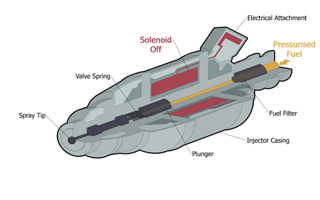 Direct impact in fuel system on all of the following crucial elements: Direct impact in fuel system on all of the following crucial elements:
Note: Contamination wear affects the entire fuel system and all internal combustion parts directly. Replacing the injectors doesn’t reverse the impact of contamination damage. The sleeves, piston, piston rings, bearings are all affected directly by contamination abrasion, heat disbursement and increased soot ,as the contamination passes through to the exhaust system.
Injector life > There is a direct correlation in wear and the sustainable cleanliness levels of fuels .Injectors are vital for optimal performance ,as they are directly responsible for the continuous optimal diesel spray pattens and the maximum possible oxidation of the fuel. Both are directly negatively impacted on by wear on the injectors.
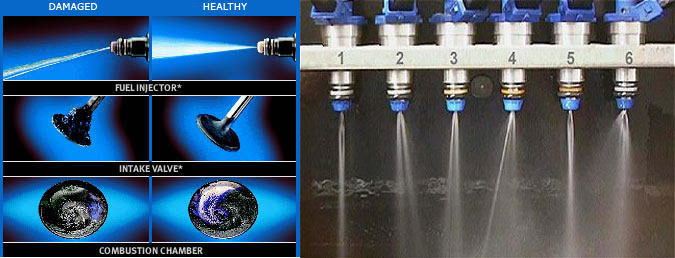
Spray pattens > injectors today have up to 12 spray holes in one nozzle and inject up to 6 to 9 times per single piston burn cycle-CAT .i.a.w very advanced. If this is directly adversely affected this leads to poor fuel oxidisation.
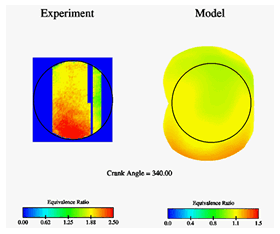 Fuel oxidisation> It is vital to optimise and maintain fuel oxidisation as it impacts on all of the following: Fuel oxidisation> It is vital to optimise and maintain fuel oxidisation as it impacts on all of the following:
Temperature disbursement Delayed or heat build up due to droplets, or worse, streams of diesel, leads to combustion chamber failure. The combustion heat does not timely disburse, resulting in the piston and sleave deforming, due to excessive heat.
Fuel consumption The wear of injectors and the internal combustion chamber directly impacts on fuel efficiency. In actual case studies this were conservatively 5 -12% over a timeline. This cost alone justifies attention and an active focus on filtration. Fuel saving alone pays for filtration costs, if not budgeted. Unburnt fuel simply increases heat, dilutes oil and exits thought the exhaust system.
Soot formation Soot is a highly abrasive substance and naturally occurs during diesel combustion, however improperly burnt fuel drastically increases soot. Soot also affects the spray pattens directly, as it deposits on the spray nozzle and increases internal abrasion wear, everywhere.
Oil dilutions Fuel and soot dilution, through poor combustion, negatively affects the functional service intervals and effectiveness of oils. This increases internal wear and leads to premature failures.
Toxic emissions Direct result of bad combustion. The excessive soot exiting and depositing on the exhaust is a clear indication of poor combustion.
Engine Lifecycles are directly economically extendable by a minimum of 20%, if fuels and oil are sustainably filtered to the required cleanliness levels. Fuels should be a minimum of
10-8 mg/kg at bulk tank levels, this is the current European specification.
Engine failures have a direct correlation to both particle and water contamination. Contamination failures are totally preventable by the implementation of a contamination blueprint. Even small improvements assist with filter capacity constraints.
Running costs are materially affected but are mostly budgeted for. We are used to treating the symptoms, not the cause, due to lack of sustainable cleanliness levels.
Running, maintenance, fuel, down-time and financial replacement costs are all directly materially impacted.
What is normal wear and how do we bench mark it? Firstly benchmarking is complicated due to a multiple of variances. However through case studies and multiple fuel sampling it is clear that contamination levels are simply above adequate. Most mining sites run between 50 -75 mg/kg. This is simply not sustainable in the future.
Minimum 20% increase in economical lifecycle on all equipment is achievable, especially on the current contamination blueprint low base levels, which are totally achievable.
Test on filtration:
- What are your current cleanliness levels on fuel and oils?
- Were correct test procedures followed for representative sample extraction?
- What does the OEM suggest in terms of cleanliness levels?
- Who actively monitors the cleanliness levels?
- Whose responsibility is it to maintain tank farms?
- Who is monitoring the changing of filtration filters and air breathers?
- Were these filters in bypass or filtration medium compromised?
- What is your contamination blueprint?
Currently most bulk filtration is totally inadequate or non-existent, placing severe capacity constraints on downstream filters. The filters simply can’t handle the sheer volume of particles, particle size and water contamination it has to contain. Downstream filters have capacity and filtration efficiency constraints. When compromised on capacity, they simply go to bypass mode or medium compromise occurs. iCerMax™ iSo-SpecSure™ filter medium is 100% sustainable, as the medium offers depth filtration without channel formation or medium compromise - it can’t even flex. That is why dirt restrained by iSo-SpecSure™s, stay in iSo-SpecSure™ filters. Vast dirt holding capacity, flow rates, service intervals, surges and sustainable cleanliness levels are all benefits of iCerMax™ .
The sole intent of this is to bring awareness to contamination and the impact on equipment.
We’ve read about contamination for years, in various publications, but seldom take correcting action .This is one of the easiest projects to implement - a contamination blueprint, with a high return, as the current market base is substandard or neglected. It is the market’s view that it is the responsibility of third parties to combat contamination. The bad news is they won’t, if they are not reimbursed for implementing and maintaining these cleanliness levels.
Facts on filtration
It is interesting to note according to OEM’s that over 75% of all engine failures is directly contributed to the fuel system or heat.
Mining houses are starting to understand the value of sustainable filtration, taking ownership of their bulk tanks and investing into cleanliness levels on oils and fuels.
This is due to a learning curve based on actual case studies and the realization of the technical advancement of equipment. Kumba –Sishen site is a model example.

Lack of sustainable filtration and inadequate design on main bulk tanks and mobile tanks leads to capacity constraints and compromises on the equipment’s water and particle filters. Contamination levels must decline, not increase during handling. A few spin-on filters or single bulk filters are inadequate to sustain the required cleanliness levels.
Filters today have efficiency – micron rating, if matched correctly BUT capacity is the “Achilles heel”, mainly due to capacity constraints and surges.
“The fuel systems of most diesel engines are equipped with water separators and two-stage fuel filters. Machine manufacturers add these or other fuel filtering systems to their equipment. Such devices will handle small amounts of contamination, but continued or excessive contamination of the fuel system will result in accelerated wear of the engine and the fuel system components “ -
Source: DEEP: intense multi million dollar study on: Diesel Emissions evaluation Program - www.deep.org
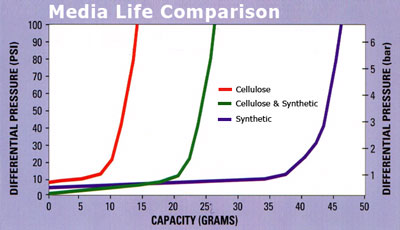 A 420 hp truck is fitted with a world leading brand filter with a maximum dirt holding capacity of 50g (premium to market standard). The SABS contamination specification is 24mg /kg, which translates (0.835) to 21mg/ltr. This means that every 50 ltr of fuel ads 1 gram of dirt to the fuel system. A 420 hp truck is fitted with a world leading brand filter with a maximum dirt holding capacity of 50g (premium to market standard). The SABS contamination specification is 24mg /kg, which translates (0.835) to 21mg/ltr. This means that every 50 ltr of fuel ads 1 gram of dirt to the fuel system.
Which translated means that in every 2500 ltr of diesel there is 50g of dirt, as is allowed per the contamination specification, thus the filter can possibly be compromised on capacity. This directly indicates that the filtration systems on trucks are periodically compromised, which leads to internal wear and which is responsible for premature failure. Especially if service intervals are taken into consideration based on distance and not volume of dirt retained in the medium. There are case studies where one BAD forecourt refueling has lead to engine failure.
Clean new oil dispensed from “new” drums are not within the required cleanliness specification of OEM‘s, especially in hydraulic oils.
The cost benefit ratio 1:10, which is fractional as to what contamination is costing in parts, fuel consumption, down-time, the logistics around breakdown, production losses, failures, back-up equipment and the lifecycles of equipment. The worst is that we delegate this
important function to third parties without accountability or reimbursement for implementation and maintaining proper sustainable cleanliness levels in our fuels and oils. Take ownership of your contamination, the rewards are more than merely financial.
We know from history that older trucks use more fuel than when they were new. One major contributor to this is the internal wear inside the engine. The contamination that has over time impacted negatively on the components, the injectors, sleeves, piston rings etc,
By introducing sustainable filtration, the wear patterns are materially reduced, therefore the fuel saving of 4-6% pays for the filtration costs over and over again.
Contamination is liquid sandpaper – water & particle - which directly affects efficiencies, warranties and lifecycles
Material balance equation of contamination
Ctn = Cto + Ca-Cs
Total contamination = Start contamination + added contamination – removed contamination
The more you remove contamination at bulk tanks, mobile tanks and on equipment, the lower your total contamination at any specific point.
“Knowing the cleanliness level of a fluid is the basis for contamination control measures” Manufacturers specify optimum cleanliness levels for fuels, oils (engine, hydraulic & gear etc.)
Useful in warranty claims if one adheres to and implements these cleanliness levels on a sustainable level.
back to top
Guage Filtration Monitoring - How Accurate Is it?
This is not an uncommon filtration site, filtration both water and particle are severely compromised. The filtration system filters installed, working indefinite.This can not happen with iCerMax™ iSo-SpecSure™s as the medium, do not compromise, and the seals are designed not to compromise either. Therefore the pressure gauges are a TRUE indication and sustainable filtration not compromised at any time.
Filtration cost in budget & working - the Gauges indicates "filters working with in working pressure"
is this necessarily a true indication?
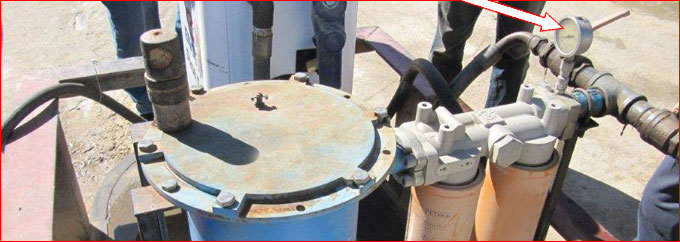
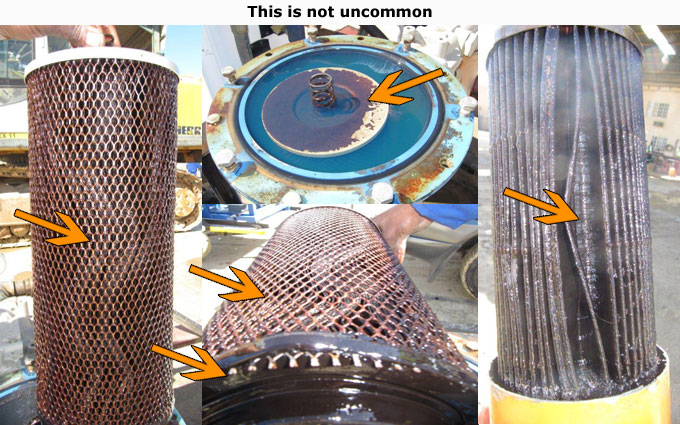
back to top
What is the impact of stop/start and surges on media?
An operating system is at risk whenever the critical contamination level is exceeded
Contamination levels determine the individual component’s wear rate (useful life) and ability to perform as intended (functionality).
System design, filter performance and maintenance practices largely determine the contamination level in a system.
Filters are expected to maintain contamination below critical tolerance levels. Filter performance in a dynamic operating system is variable based upon flow rate and flow density, changes in flow rate (duty cycle), viscosity, fluid and structure borne vibration (Hz), contamination levels, ingression rate and several other conditions. All filters are subjected to some form of system dynamics.
Filters encounter frequent and rapid changes in flow rate accompanied by frequency changes. Bulk tank filters typically experience dynamic conditions during start up and shut down.
Two key characteristics of filter performance are capture efficiency and retention efficiency.
Capture efficiency can be thought of simply as how effectively a filter captures particles while Retention efficiency is a measure of how effectively that filter retains the particles it has captured. A filter is not a black hole, and its performance must not be based solely on how efficiently it captures particles. If not properly designed and applied, a filter can become one of the most damaging sources of contamination in a system.
- The phenomenon of releasing captured contaminant is called unloading, and can result in temporary contamination levels, that are well above the critical contamination tolerance level of a system.
- This phenomenon can best be described as "contaminant unloading". As the Filter element captures more dirt, greater amounts may be released back into the system that it is installed to protect when the element is subjected to a dynamic flow condition and change in differential pressure across the element. Unloading may also occur when the flow rate changes from high flow to low flow, represented by the alternating smaller peaks . The filter element typically recovers shortly after the dynamic condition, but highly contaminated clouds of fluid from contaminant unloading can cause severe component damage and unreliable system performance.
- Excessive unloading in the early stage of element life may be symptomatic of an element that will eventually fail and lose it’s efficiency all together (media breakdown).
 
- During the restart-Cold start test there is no contaminant being injected so any particles measured were already in the system or were released by the element (unloading). The result is a temporary state of highly contaminated fluid that has resulted because the filter element did not properly retain the dirt.
Filter element performance is at it’s worst during flow changes isolating those sequences can help predict performance in dynamic flow systems
The advantages of using iSo-SpecSure™ filters:
- Multi- functional wear resistant (Pyrites) iSo-SpecSure™ filtration medium – ideal for air, gas & liquids or any combination of these and for industrial applications.
- There is surety of sustainable cleanliness levels, compared to other market filtration mediums, as iCerMax™ iSo-SpecSure™’s don’t form channels, don’t have medium migration and there is no severe unloading or element collapse. iCerMax™ iSo-SpecSure™s possess a non-flexi depth medium.
- Structural integrity, iCerMax™ eliminates filtration medium breakdowns or compromise caused by multiple surges , hammering effects, operating pressures ( high or low ), severe pressure variances, extreme heat -800 degrees plus , chemicals, surfactants ,water ,acids, biocides or expiry dates, etc.
- Excellent sustainable Capture efficiency –unsurpassed Micron ratings even under severe pressures and surges.
- Holding capacity and dirt retention (the main “Achillis heel” of various filtration mediums) are exceeded, as dirt remains in the filter due to the unsurpassed structural integrity of the filter medium i.a.w there is no costly dirt surges or any seepage that negatively affect or compromise the cleanliness levels.
- Reliable filtration monitoring sensors/ pressure gauges. As the medium does not compromise the filtration monitoring sensors reflect the actual real time status of the filtration process thus eliminating estimated change intervals based on shifts, volume, or on hourly or distance monitoring.
- Process applications efficiencies: the inherent characteristics of iCerMax™ allow for a functional optimisation design of processes, which requiring a superior multi functional filtration solution.
- With higher pressures/ flow rates and their vast dirt holding capacity iCerMax™ iSo-SpecSure™s set new standards in bulk filtration sustainable cleanliness levels and totally in a league of their own.
 Fleetwatch May 2009 - Diesel fuel and why engines fail - Patrick Swan Fleetwatch May 2009 - Diesel fuel and why engines fail - Patrick Swan
 Fleetwatch - A few microns can punch massive holes At von Wiellig Fleetwatch - A few microns can punch massive holes At von Wiellig
back to top |







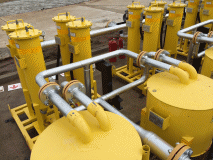
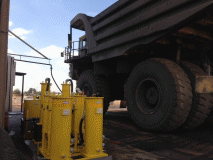
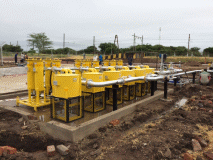
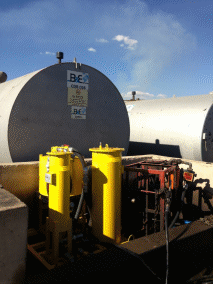

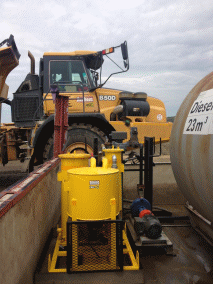






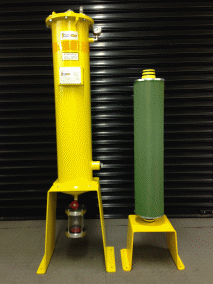
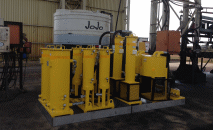

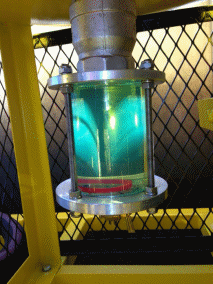
 Utilise the coalesce principle - a reliable, proven and effective method. Highly effective water separation without the cost of expensive cartridges that collapse with a high volume of water concentrate and whose efficiency is compromised by particle contamination. Automatically dumps water in 500ml intervals.
Utilise the coalesce principle - a reliable, proven and effective method. Highly effective water separation without the cost of expensive cartridges that collapse with a high volume of water concentrate and whose efficiency is compromised by particle contamination. Automatically dumps water in 500ml intervals.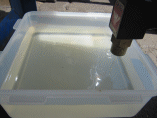
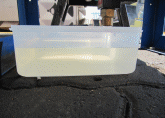



 iCerMax™ iSo-SpecSure™ & desiccant air vent breathers for bulk tanks
iCerMax™ iSo-SpecSure™ & desiccant air vent breathers for bulk tanks

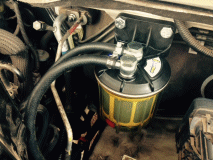
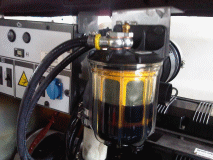
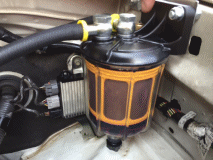
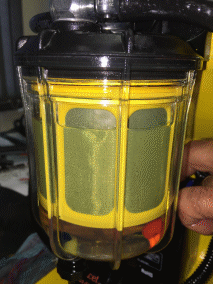
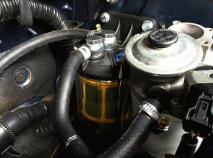
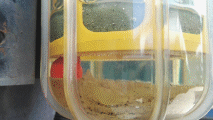
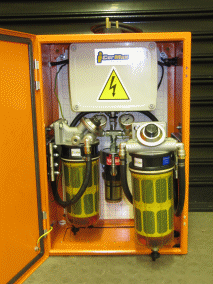


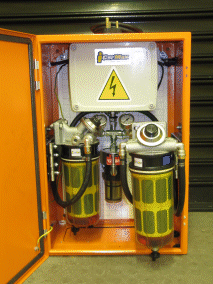
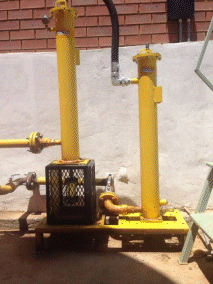
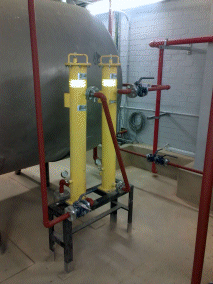


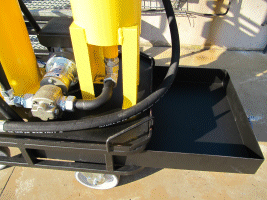
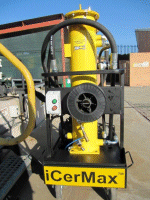
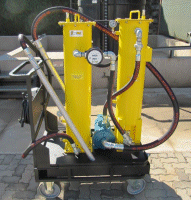
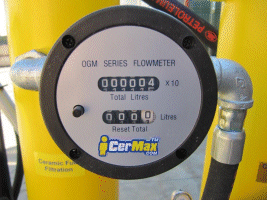
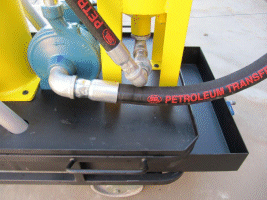

 Fuel/Oil Portable Kidney: filtration trolley (customised litre per minute)
Fuel/Oil Portable Kidney: filtration trolley (customised litre per minute) Combo unit
Combo unit 


 Both hard and soft contaminants penetrate into the depth
media. It captures contaminants within its structure, as opposed to
on the surface.
Both hard and soft contaminants penetrate into the depth
media. It captures contaminants within its structure, as opposed to
on the surface.


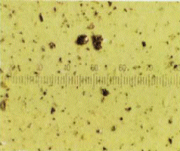


 Direct impact in fuel system on all of the following crucial elements:
Direct impact in fuel system on all of the following crucial elements:
 Fuel oxidisation> It is vital to optimise and maintain fuel oxidisation as it impacts on all of the following:
Fuel oxidisation> It is vital to optimise and maintain fuel oxidisation as it impacts on all of the following: 
 A 420 hp truck is fitted with a world leading brand filter with a maximum dirt holding capacity of 50g (premium to market standard). The SABS contamination specification is 24mg /kg, which translates (0.835) to 21mg/ltr. This means that every 50 ltr of fuel ads 1 gram of dirt to the fuel system.
A 420 hp truck is fitted with a world leading brand filter with a maximum dirt holding capacity of 50g (premium to market standard). The SABS contamination specification is 24mg /kg, which translates (0.835) to 21mg/ltr. This means that every 50 ltr of fuel ads 1 gram of dirt to the fuel system. 


